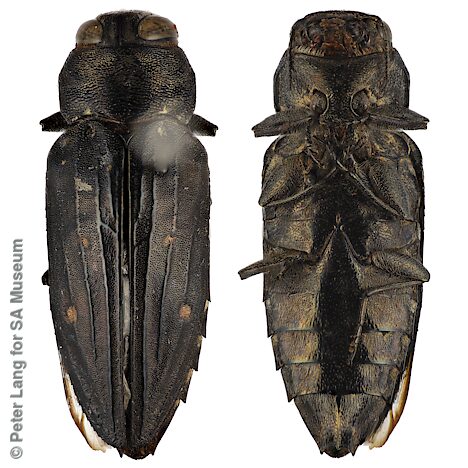
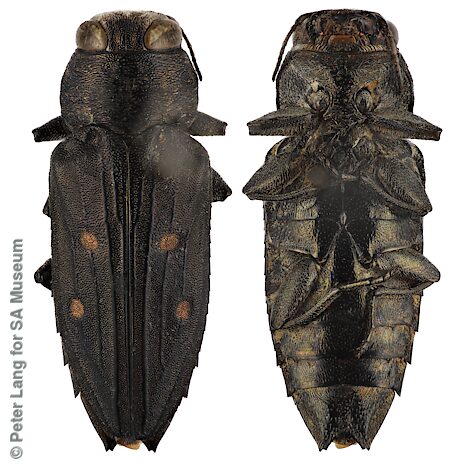

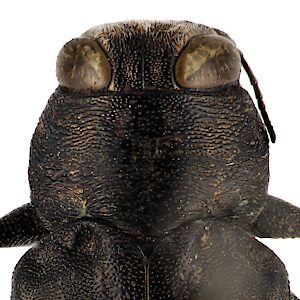
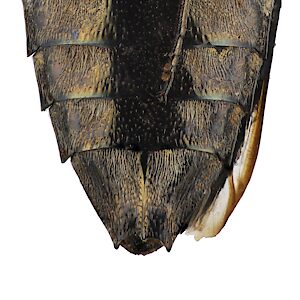
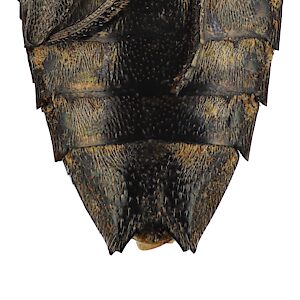
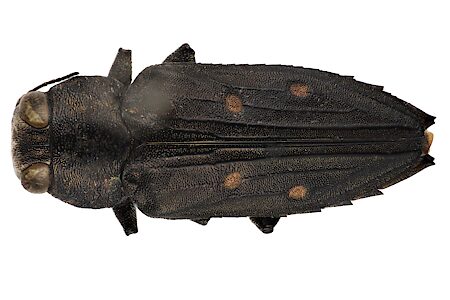
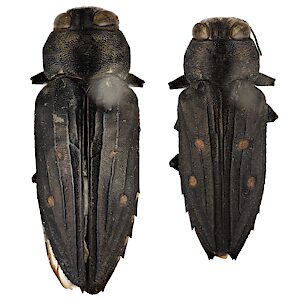
size¹:
×
6.1 mm








| male | female | |||||
|---|---|---|---|---|---|---|
| L1 | 13.8 | 13.6 – 14 | n = 3 | 17.4 | 16.6 – 18.05 | n = 5 |
| L2 | 13.5 | 13.3 – 13.6 | n = 3 | 17.1 | 16.2 – 17.8 | n = 5 |
| W | 5.3 | 5.2 – 5.3 | n = 3 | 6.6 | 6.3 – 7 | n = 5 |
| Legend | L1 | length from clypeus/frons to elytral apex (mean, range, sample size) |
| L2 | length from anterior of edge of eyes to elytral apex | |
| W | maximum width with elytra fully closed |
A distinctive, large, dark-coloured species, elongate in body shape, with elytra tapering somewhat acutely towards apex in their posterior 1/3. Medial pronotum in posterior 2/3 raised with prominent closely spaced transverse striae; elytra with discrete and strongly raised ribs, and anterior (basal) foveae pair that are deep and often powdery white within. Apical ventrite with wide incision, bordered by teeth that are bilobed in male (apex quadridentate in male, but tridentate in female which also has a median tooth extending from a median carina).
A common and widely distributed arid zone species.
| Legend | P.J.Lang collection vouchered records | |
| other private collection or museum specimens, or sightings |
|
|
|
|
|
|
|
|
|
|
|
|
|
||||||||||||||||||||||||||||||||||||||||||||||||
|
|
|
|
|
|
|
|
|
|
|
|
|
||||||||||||||||||||||||||||||||||||||||||||||||
| Jul | Aug | Sep | Oct | Nov | Dec | Jan | Feb | Mar | Apr | May | Jun |
| Legend | ||
9 | number of active beetles, actually recorded in that quarter-month | |
| actual count > 2.5 (mean) | ||
| actual count <= 2.5 (mean) | ||
| live non-emerged (inactive) beetles only | ||
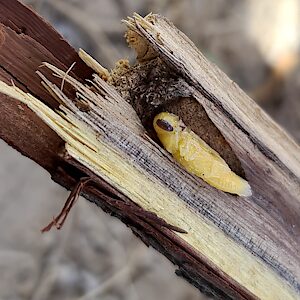
 dead branch as pupa, LE, but died during ecdysis, R1_x300.jpg)
 dead branch as pupa, LE, died during ecdysis, R2_x300.jpg)
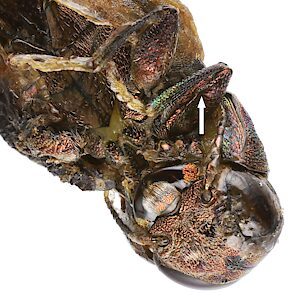
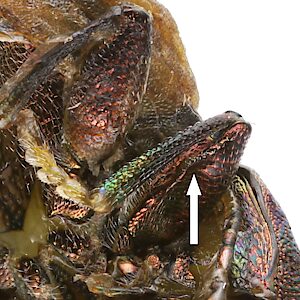
 dead branch, pronotum with horizontal striae, LE, R5_x300.jpg)
 dead branch, apical abdominal ventrite with carina and tridentate apex, LE, R6_x300.jpg)
| records | sites | SA regions¹ | family | adult ex pupa | pupa | |
| Acacia stenophylla | 2 | 1 | LE | F | 1 | 1 |
| Legend | records | count of breeding adults, pupae and larvae |
| sites | count of major sites (unique 10 km grid cells +/- some distinct approximate localities) | |
| adult | live = extracted alive; dead = extracted dead as intact or fragmentary remains; ex billet = reared and emerged from stored sections of host; ex pupa = reared from sampled pupa | |
| pupa | extracted pupa; pupa ex larva = reared pupa from larva | |
| larva | extracted larva (any stage including prepupa) | |
| gall (only) | hatched or unhatched gall identified by form and position rather than contents | |
| Plant names in green are hyperlinked to a matching host species page with plant photos. | ||
| Code | records | % | host plant taxa | |
| F | Fabaceae | 2 | 100% | 1 |
| position | records | sites | adult ex pupa | pupa | |
| dead stem | 2 | 1 | 1 | 1 |
The single breeding record here, in River Cooba Acacia stenobotrya, is based on an incompletely developed adult reared from a pupa. Originally it was treated here as C. mastersii due to its bright colouration, but this is now attributed to its immaturity and it is identified as C. subsimilis. This is supported by: details of the apical abdominal sternite including its flat shape, median carina, and tridentate apex characteristic of females in this species; the very shiny sternum with sparse punctae including some that are small and indistinct; and the posterior half of the median pronotum bearing well-developed, closely spaced and coalescing horizontal striae/ridges.
| ¹ Legend | regions | SA State Herbarium regions (map) EA: Eastern, EP: Eyre Peninsula, FR: Flinders Ranges, GT: Gairdner-Torrens, KI: Kangaroo Island, LE: Lake Eyre, MU: Murray, NL: Northern Lofty, NU: Nullarbor, NW: North-Western, SE: South-Eastern, SL: Southern Lofty, YP: Yorke Peninsula |
| size | The ellipse is the correct size when printed, indicative on a desktop screen, and likely to be wrong on a mobile device. |